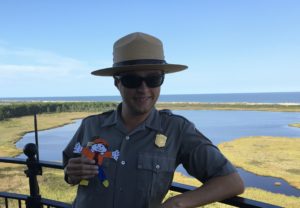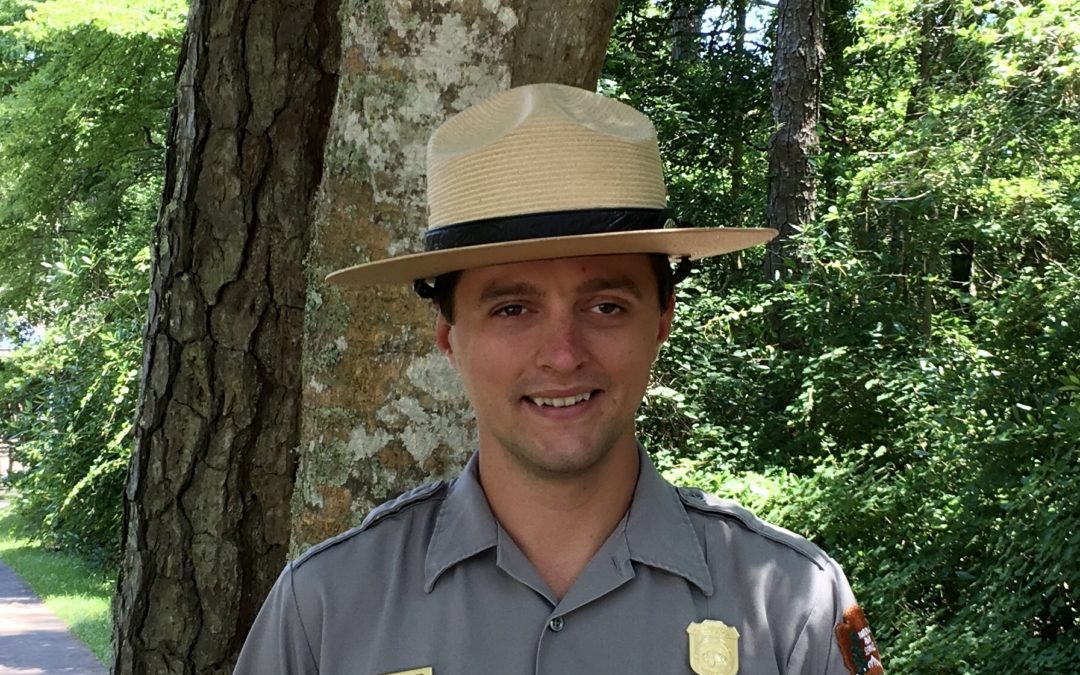Our Meet Your Ranger series introduces you to the many amazing people who support our Outer Banks national parks every day!
Please tell us a little bit about yourself.
Hometown: Williamsburg, Virginia
Education: B.A. in American History, University of North Carolina
Position in our Outer Banks national parks: I work in the Administrative Division as our Property Management Technician overseeing the parks’ property, fleet, and housing programs.
Where you can be found: Park Headquarters, Manteo
Other national parks you have worked at: I’ve bounced around our three Outer Banks national parks in various positions over the last seven years working at Oregon Inlet Campground, Wright Brothers National Memorial Entrance Station, Bodie Island Lighthouse, Bodie Island Off Road Vehicle Permit Office, and even Human Resources at Headquarters.

Ranger Thomas with the “Flat Stanley” character at the top of the Bodie Island Lighthouse.
Currently reading/watching/listening to: Elmo. My almost-two-year-old son Bennett is the biggest fan of this accomplished actor, singer, and songwriter. Therefore, I simply cannot go a day with reading out loud or watching his finest works.
What do you like to do in your free time? I enjoy spending time with my family and being outside. Whether it’s driving on the beach, offshore fishing, surfing, kayaking, or just working in the yard, it’s nice to be in the great outdoors.

Ranger Thomas with his B.A.R.K Ranger, Jackson, on the boardwalk in front of the Bodie Island Lighthouse.
What do you like most about the Outer Banks? It’s an incredible place with a unique culture and history. With a local population in the tens of thousands and visitation in the millions annually, it somehow maintains a small town feel where everybody knows everybody.
What inspired you to follow this career path? I left college with a four-year history degree, a two-year business degree, and a minor in marine science. I didn’t know what to do with those, or how these three different disciplines could ever be used together. Then about a year later it became obvious, Cape Hatteras: The nation’s first national seashore. It has centuries of history, miles of beaches, and it’s all managed by a large, well-known organization.
What does a typical workday or work week look like for you? While a lot of my work these days involves looking at spreadsheets and emails, it’s far from monotonous. I spend a lot of time resolving tenant issues with the parks’ 36 houses and 20 recreational vehicle sites that we offer to our staff and volunteers. Likewise, we have a fleet of nearly 100 highway vehicles from sedans to dump trucks. Keeping up with maintenance, damage, recalls, replacements, and corrosion is a full-time job.
What do you enjoy most about working in our Outer Banks national parks?
The job diversity in this organization is incredible. If there’s a career you want, the National Park Service probably has a version of it. I’ve always felt empowered here to learn a new skill or help a coworker with their job. Because of that, I’ve gotten to do things like band pelicans on remote islands, give interpretive talks, instruct off-road vehicle driving, participate in federal disaster recovery efforts, and help our law enforcement rangers with scenario-based training.
What is a favorite memory you have from your time working in the Outer Banks?
I’ve always had family in the area, and I spent much of my childhood here, so I enjoy being able to share my firsthand experiences of things like watching the Cape Hatteras Lighthouse move in 1999, attending the Wright Brothers Centennial in 2003, or witnessing the damage caused by any of the big hurricanes (Isabel, Irene, Matthew, Dorian).
Why are our Outer Banks national parks important?
The Outer Banks is a significant geological, environmental, and historical area. Much of the nation’s history can be connected directly to this ribbon of sand. But it’s also just a really nice place to spend the summer. Without the National Park Service, the area might be more developed, have less public access, and perhaps fewer historic structures remaining.
Is there anything else you would like people to know about you or about our Outer Banks national parks?
While a typical visitor is likely to only have brief contact with a ranger at a visitor center or campground, there are a lot of people working behind the scenes to make sure everyone has a great visit. Equipment gets purchased, utility bills get paid, a small army of seasonal workers are hired and trained each summer, agreements are written with other organizations, and a staggering number of laws, regulations, and policies are followed in order to maintain the public trust.
Also, did you know the Outer Banks national parks have been on the forefront of electric vehicle technology for years?
Since 2017, the parks have had an electric vehicle. In 2021, Wright Brothers National Memorial showcased CASSI, an electric autonomous shuttle which drove visitors around the park. In 2022, the parks received two out of six electric pickup trucks they have on order. Not to mention all the electric leaf blowers, string trimmers, UTV’s, even an electric riding lawn mower which all really help to reduce unwanted noise around the parks.

